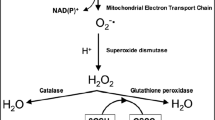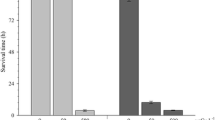Abstract
Ten lots of common carp and six lots of crucian carp (each lot of 100 fish) were treated under anoxia for five days at water temperatures of 25–31°C. The average per group mortality of common carp was 17%, but none of the 600 crucian carp died. The digestive tract tissues of the common carp that died had significantly lower zinc concentrations than those that survived (59±41 vs 142±60 μg/[g fresh tissue], P<0.001). The digestive tract tissues of the crucian carp had mean zinc concentrations of 652±458 μg/(g fresh tissue). One lot of common carp that had low tolerance for anoxia was fed a high zinc diet (2000 mg zinc/kg diet) for 1, 2 or 6 months and then subjected to 5 days anoxia. The survival rates of those fed the high zinc diet 1 and 2 months increased from 0 to 50%, respectively; all of fish that had fed a high zinc diet for 6 months survived. Thus, anoxia survival in common carp and crucian carp is closely related to the high concentrations of zinc in their tissues.
Similar content being viewed by others
References
Zhou BS, Wu RSS, Randall DJ, Lam PKS, Ip YK, Chew SF, Metabolic adjustments in the common carp during prolonged hypoxia. J. Fish. Biol. 2000; 57: 1160–1171.
van den Thillart G, van Waarde A. Teleosts in hypoxia: aspects of anaerobic metabolism. Mol. Physiol. 1985; 8: 393–409.
van Raaij MTM, van den Thillart GEEJM, Vianen GJ, Pit DSS, Balm PHM, Steffens AB. Substrate mobilization and hormonal changes in rainbow trout (Oncorhynchus mykiss L.) and common carp (Cyprinus carpio L.) during deep hypoxia and subsequent recovery. J. Comp. Physiol. 1996; 166B: 443–452.
Nilsson GE. Oxygen availability: brain defence mechanisms. In: Hochachka PW, Momsen TP (eds). Biochemistry and Molecular Biology of Fishes. Elsevier, Amsterdam, 1995; 19–44.
Stecyk JAW, Farrell AP. Regulation of the cardiorespiratory system of common carp (Cyprinus carpio) during severe hypoxia at three seasonal acclimation temperatures. Physiol. Biochem. Zool. 2006; 79: 614–627.
Nilsson GE, Renshaw GMC. Hypoxic survival strategies in two fishes: extreme anoxia tolerance in the North European crucian carp and natural hypoxic preconditioning in a coral-reef shark. J. Exp. Biol. 2004; 207: 3131–3139.
Hambidge KM, Casey CE, Krebs NF. Zinc. In: Mertz W (ed.). Trace Elements in Human and Animal Nutrition. Academic Press, Orlando, FL. 1986; 1–138.
National Research Council, Committee on Medical and Biological. Effects of Environmental Pollutants, Zinc. University Park, Baltimore, ML. 1979; 88–96.
Jeng SS, Huang YW. Heavy metal contents in Taiwan’s cultured fish. Bull. Inst. Zool. Acad. Sini. 1973; 12: 79–85.
Sun LT, Jeng SS. Comparative zinc concentrations in tissues of common carp and other aquatic organisms. Zool. Stud. 1998; 37: 184–190.
Jeng SS, Wang JT, Sun LT. Zinc and zinc binding substances in the tissues of common carp. Comp. Biochem. Physiol. 1999; 122: 461–468.
Jeng SS, Wang MS. Isolation of a Zn-binding protein mediating cell adhesion from common carp. Biochem. Biophys. Res. Commun. 2003; 309: 733–742.
Liao HJ, Chen YH, Jeng SS. Association of zinc with connective tissue in the digestive tract of common carp. Fish. Sci. 2006; 72: 893–902.
Ogino C, Takeuchi L, Takeda H, Watanabe T. Availability of dietary of dietary phosphorous in carp and rainbow trout. Bull. Jap. Soc. Sci. Fish. 1979; 45: 1527–1532.
Sun LT, Jeng SS. Accumulation of zinc from diet and its release in common carp. Fish. Physiol. Biochem. 1999; 20: 313–324.
Shoubridge EA, Hochachka PW. Ethanol: novel end product of vertebrate anaerobic metabolism. Science 1980; 209: 308–309.
Jeng SS, Yau JY, Chen YH, Lin TY, Chung YY. High Zn in the erythrocyte plasma membranes of common carp Cyprinus carpio. Fish. Sci. 2007; 73: 421–428.
Boutilier RG. Mechanisms of cell survival in hypoxia and hypothermia. J. Exp. Biol. 2001; 204: 3171–3181.
Hochachka PW, Lutz PL. Mechanism, origin, and evolution of anoxia tolerance in animals. Comp. Biochem. Physiol. 2001; 130B: 435–459.
Lutz PL, Nilsson GE, Prentice HM. The Brain Without Oxygen: Causes of Failure- Physiological and Molecular Mechanisms for Survival. Kluwer Academic Publishers, Dordrecht. 2003.
Hochachka PW. Defence strategies against hypoxia and hypothermia. Science 1986; 231: 234–241.
Bettger WJ, O’Dell BL. A critical physiological role of zinc in the structure and function of biomembranes. Life Sci. 1981; 28: 1425–1438.
Bettger WJ, O’Dell BL. Physiological roles of zinc in the plasma membrane of mammalian cells. J. Nutr. Biochem. 1993; 4: 194–207.
Author information
Authors and Affiliations
Corresponding author
Rights and permissions
About this article
Cite this article
Jeng, S.S., Lin, T.Y., Wang, M.S. et al. Anoxia survival in common carp and crucian carp is related to high zinc concentration in tissues. Fish Sci 74, 627–634 (2008). https://doi.org/10.1111/j.1444-2906.2008.01567.x
Received:
Accepted:
Issue Date:
DOI: https://doi.org/10.1111/j.1444-2906.2008.01567.x




